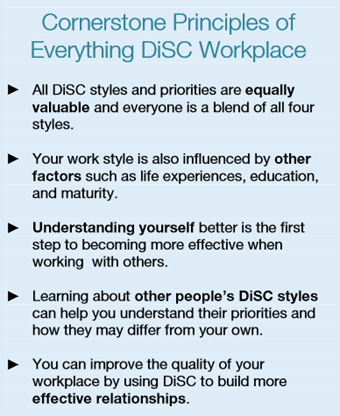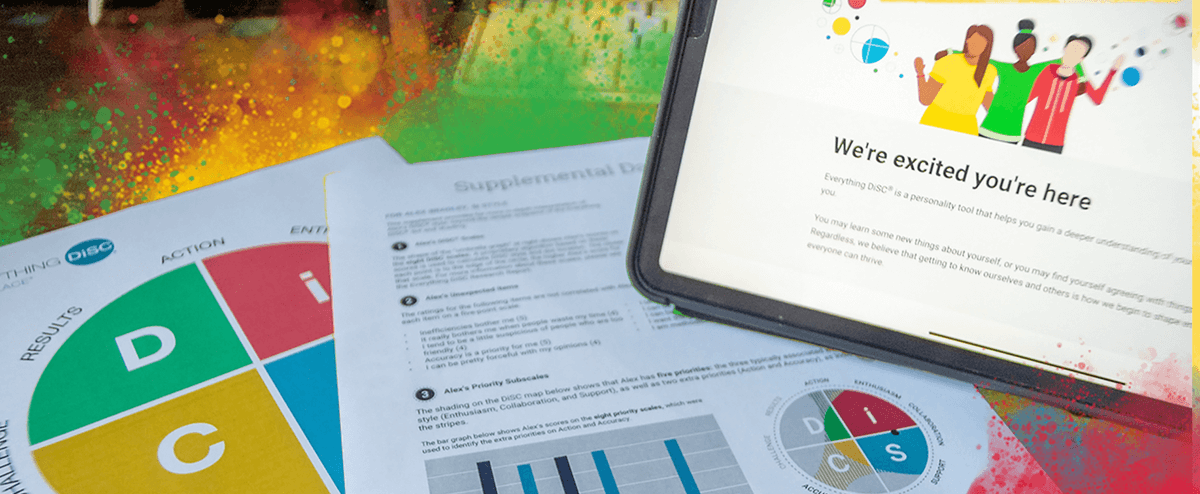
How DiSC® works
What does DiSC measure?
DiSC® measures dimensions of your personality. It does not measure intelligence, aptitude, mental health, or values. DiSC profiles describe human behavior in various situations—for example, how you respond to challenges, how you influence others, your preferred pace, and how you respond to rules and procedures. It measures tendencies and preferences, or patterns of behavior, with no judgment regarding value or alignment with a skill set or job classification. DiSC is a tool for dialogue, not diagnosis.
At its broadest, DiSC measures four aspects of personality: dominance (D), influence (i), steadiness (S), and conscientiousness (C). These are the foundational traits from the original DISC model.
The Everything DiSC family of products expands on these four quadrants, providing greater insight for specific purposes (managing others, leadership, sales, or conflict, for example). Everything DiSC measures eight scales (D, iD/Di, i, iS/Si, S, SC/CS, C, and CD/DC) as well as priorities during the assessment process.
The assessment questionnaire
The Everything DiSC assessment asks you to respond to simple statements on a five-point scale where you indicate how much you agree with each statement.
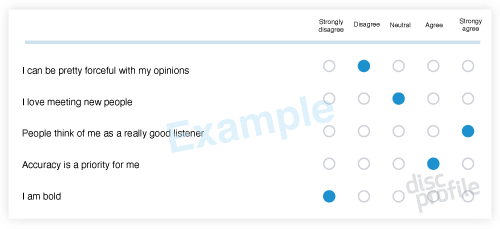
You're regarded as the expert on yourself. There are no right or wrong answers. This online questionnaire takes only about 15 to 20 minutes to complete and includes approximately 80 items. Computerized adaptive testing is used to produce the most accurate results.
You don’t need to focus on one area of your life while answering the questionnaire. You can think about how you behave in different scenarios—at work, at home, and socially. It won’t significantly change your results.
Your results and profile report
You might get your results immediately after completing the questionnaire, or a facilitator might hold your results until you meet with them.
In your profile, you'll read about your unique behavioral style, your tendencies, needs, preferred environment, and strategies for effective behavior. Each profile report also includes information about other DiSC styles to help you learn more about others. Facilitators might use the Everything DiSC Comparison, Group Culture, or other reports to provide a greater understanding of your team, group, clients, or colleagues.
The language of the narrative in your profile is supportive, personalized, and easily understood without the intervention of an assessment professional. However, a good coach or facilitator can help you discover ways of applying what's in your profile.
There are no preferred styles. Yes, you might be given a label as a high S or a Di, but there are no value judgments in that label. Your style does not indicate that you'll be good at one type of job over another, for example. Each style has the potential to flex or stretch into other styles when needed. It might just take extra energy or some practice.
You’re not either this or that. Sometimes people get worried that they will be seen as being one way in all circumstances. Everything DiSC reports use a dot within a circle of styles to show that everyone exhibits traits of all four major styles. The adaptive testing method makes it even easier to discover your innate style, but innate never means exclusive. For example, the Everything DiSC Sales profile is based on a salesperson being able to adapt their style to complement or match the style of the buyer.
You'll also see that your profile indicates that you have at least three priorities (or mindsets in Agile EQ). These will differ depending upon which Everything DiSC profile you receive. Approximately one-third of respondents will receive an extra priority or two in their report. You can have up to five priorities, although there's no extra value for having more than three.
Scoring the DiSC assessment
Scoring is done electronically for Everything DiSC profiles. Each of the eight DiSC scales is measured, but these scores do not show on the profile report. Instead, a person's dot placement is displayed in a circular image. This has proved to be more engaging, memorable, and informative than a series of numbers or graphs.
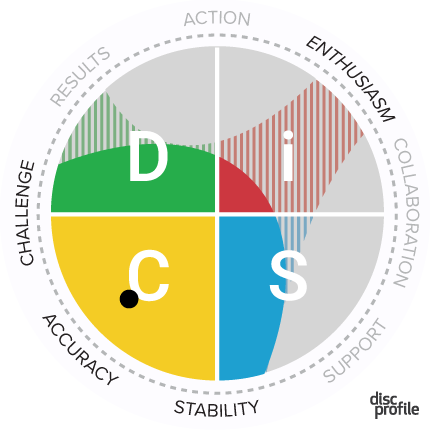
A specialized report is available for the facilitator, however. The Everything DiSC Supplement for Facilitators is a one-page report that provides more detailed data about a respondent’s DiSC style and dot placement. It provides scores for all eight DiSC scales and can be very helpful for coaches and facilitators to use with individuals whose dots are closer to the center of the circle.
The report also lists the questionnaire items a person rated highly but that aren’t typical for someone with their style. This may help undercover the nuances of the person’s style, making it a better fit and more relevant.
Personality assessments
Psychologists have been measuring personality traits since the 1930s. Since that time they have strived to better understand personality and to create ways of measuring it. They have become more aware of the complexity of interactive forces that are responsible for any one behavior.
DiSC assessments differ in method and purpose from instruments used in clinical settings to determine the emotional health of individuals. DiSC is used to help people understand themselves and others in the range of normal human behaviors.
Familiar to many is the Myers-Briggs Type Indicator® (MBTI®). A perennial discussion exists among consultants and others about which profile is the best. A better question is: Which assessment better fits your needs? Issues around who will do the training and how much time you have for it might influence your decision. DiSC is seen by many to be more memorable, with more uses in the workplace.
Because the two instruments provide different kinds of information, they might very well augment each other as separate views of the same person. DiSC measures the traits of dominance and submissiveness–common issues in relationships–which the MBTI does not. In addition, the DiSC model does not meaningfully measure constructs such as structure (J-P) or abstractness (S-N).
However, there is some correlation between the MBTI Introversion-Extroversion scale and the DiSC moderate–fast-paced dimension or i scale and the skeptical–accepting dimension or C scale. There is also a moderate relationship between Thinking-Feeling construct of the MBTI and skeptical–accepting measurements of DiSC.
Many other assessments are also available – you can learn the difference between DiSC and DISC on our blog. We recommend you choose one based on its reliability and validity, your own training needs, and what you want your learners to take away from their experience.
FAQs about DiSC profiles
Everything DiSC is normed so there is an even distribution of styles. A person is only D relative to the people around them. A person is only C relative to the people around them. For example, imagine that we have a plane full of S-style folks and the plane crashes on a remote island. We would have an island full of very polite people. But imagine that isolated community 10 years later. Some of those people would now probably be considered D styles because they are more dominant relative to everyone else. If DiSC is going to be useful, it must help us understand our individual differences, not what everyone has in common.
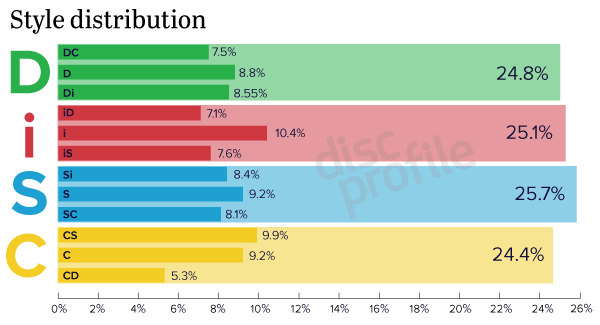
The colors themselves are not representative or relevant to the actual styles in any way. They are design and branding choices that differentiate Everything DiSC from other assessments.

Inscape (now Wiley) was the first to use the circumplex model and they chose colors to visually differentiate the styles. They show how someone has aspects of each style. It's obvious through the color shading that someone with a C-style also has a bit of D, i, and S.
A perennial discussion exists among consultants and others about which profile is the best. That’s not really the best question to ask. A better one is: Which assessment better fits your needs?
There is some correlation between the MBTI Introversion–Extroversion scale and the DiSC moderate–fast-paced dimension or i scale and the skeptical–accepting dimension or C scale. There is also a moderate relationship between the Thinking-Feeling construct of the MBTI and skeptical–accepting measurements of DiSC.
The DiSC model does not meaningfully measure constructs such as structure (J-P) or abstractness (S-N).
Everything DiSC measures the traits of dominance and submissiveness–common issues in relationships–which the MBTI® does not.
People agree with the narrative descriptions of their styles
“Overall, participants report that the DiSC fit is good or excellent approximately 90% of the time. As documented under the Forer effect (1949), however, it is not unusual for participants to show a high level of agreement with psychological test results.”
Observers also show agreement
“… a study was conducted to examine the relationship between DiSC assessment results and observer ratings of leadership behavior. … The results of the analysis were largely as expected under the theoretical DiSC model. For 71% of the [leadership] practices, the expected style had the highest mean. For 88% of the practices, the expected style was among the top two highest means.”
Source: Everything DiSC Manual
Validation results for each of the Everything DiSC profiles are available in the Everything DiSC Research Report.
No. There are no wrong or right answers. One of the cornerstone principles of Everything DiSC is that all DiSC styles and priorities are equally valuable and everyone is a blend of all four styles.
Certification is not required to administer or interpret the Everything DiSC assessment. We do offer facilitation kits and certification for those who are interested. See DiSC certification and kits.
DiSC Classic is the original assessment based on the DiSC model. If you need to use a paper-based assessment, this is the one we recommend. For all other needs, we recommend one of the Everything DiSC profiles. Why?
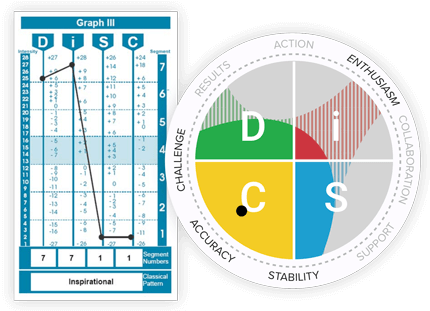
- Participants find the reports more personal and relevant. Everything DiSC profiles are based on around 80 items (adapted to respondent's previous answers) instead of the 28 used by DiSC Classic. The circle model measures eight scales compared to the four of the graph model. This makes for a more precise assessment.
- The circle model is more intuitive and memorable. The shading of the circle better illustrates how we are all D, i, S, and C. It clearly illustrates how we're capable of adapting our behavior and using styles outside our own.
- The assessment is easier to take, especially for non-native speakers of English. The questions don’t force you to choose from four words the two that describe you most and least, as does DiSC Classic. It uses a rating scale that's much easier for most people to complete.
- Robust DIY trainer kits mean you don’t have to hire a consultant to administer and score the assessment or to train participants. The videos included in the kits are contemporary and better reflect today’s workplace.
Sure! When you buy an online profile you will receive an email with a link to the assessment. Just forward that email to your friend, family member, or colleague. They can then click on the link, set up a password-protected account, and take the assessment. They will be able to view and download their profile as soon as they complete the assessment. You will not be able to see their results unless they choose to share them with you.
We recommend using DiSC with adults only; however, the reading level for all profiles is aimed at a 5th grade reading level. The questionnaire has a Flesch Reading Ease score of 74.2 and Flesch-Kincaid Grade Level of 4.7 and there is no time limit for completing it. We have customers who have used Everything DiSC Workplace or The Five Behaviors Personal Development with older teens, but our products have not been validated with a younger population.


